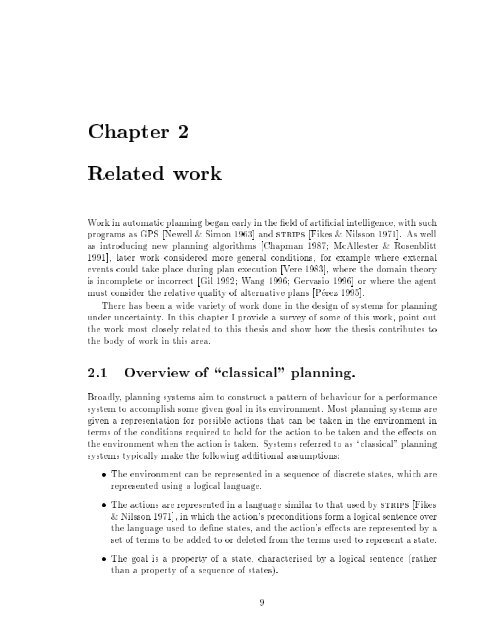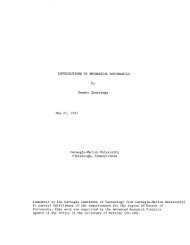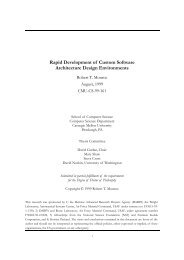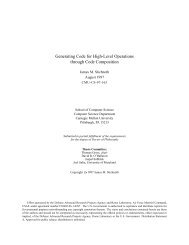Planning under Uncertainty in Dynamic Domains - Carnegie Mellon ...
Planning under Uncertainty in Dynamic Domains - Carnegie Mellon ...
Planning under Uncertainty in Dynamic Domains - Carnegie Mellon ...
Create successful ePaper yourself
Turn your PDF publications into a flip-book with our unique Google optimized e-Paper software.
Chapter 2Related workWork <strong>in</strong> automatic plann<strong>in</strong>g began early <strong>in</strong> the eld of articial <strong>in</strong>telligence, with suchprograms as GPS [Newell & Simon 1963] and strips [Fikes & Nilsson 1971]. As wellas <strong>in</strong>troduc<strong>in</strong>g new plann<strong>in</strong>g algorithms [Chapman 1987; McAllester & Rosenblitt1991], later work considered more general conditions, for example where externalevents could take place dur<strong>in</strong>g plan execution [Vere 1983], where the doma<strong>in</strong> theoryis <strong>in</strong>complete or <strong>in</strong>correct [Gil 1992; Wang 1996; Gervasio 1996] or where the agentmust consider the relative quality of alternative plans [Perez 1995].There has been a wide variety ofwork done <strong>in</strong> the design of systems for plann<strong>in</strong>g<strong>under</strong> uncerta<strong>in</strong>ty. In this chapter I provide a survey of some of this work, po<strong>in</strong>t outthe work most closely related to this thesis and show how the thesis contributes tothebodyofwork <strong>in</strong> this area.2.1 Overview of \classical" plann<strong>in</strong>g.Broadly, plann<strong>in</strong>g systems aim to construct a pattern of behaviour for a performancesystem to accomplish some given goal <strong>in</strong> its environment. Most plann<strong>in</strong>g systems aregiven a representation for possible actions that can be taken <strong>in</strong> the environment <strong>in</strong>terms of the conditions required to hold for the action to be taken and the eects onthe environment when the action is taken. Systems referred to as \classical" plann<strong>in</strong>gsystems typically make the follow<strong>in</strong>g additional assumptions: The environment can be represented <strong>in</strong> a sequence of discrete states, which arerepresented us<strong>in</strong>g a logical language. The actions are represented <strong>in</strong> a language similar to that used by strips [Fikes& Nilsson 1971], <strong>in</strong> which the action's preconditions form a logical sentence overthe language used to dene states, and the action's eects are represented by aset of terms to be added to or deleted from the terms used to represent a state. The goal is a property of a state, characterised by a logical sentence (ratherthan a property of a sequence of states).9







